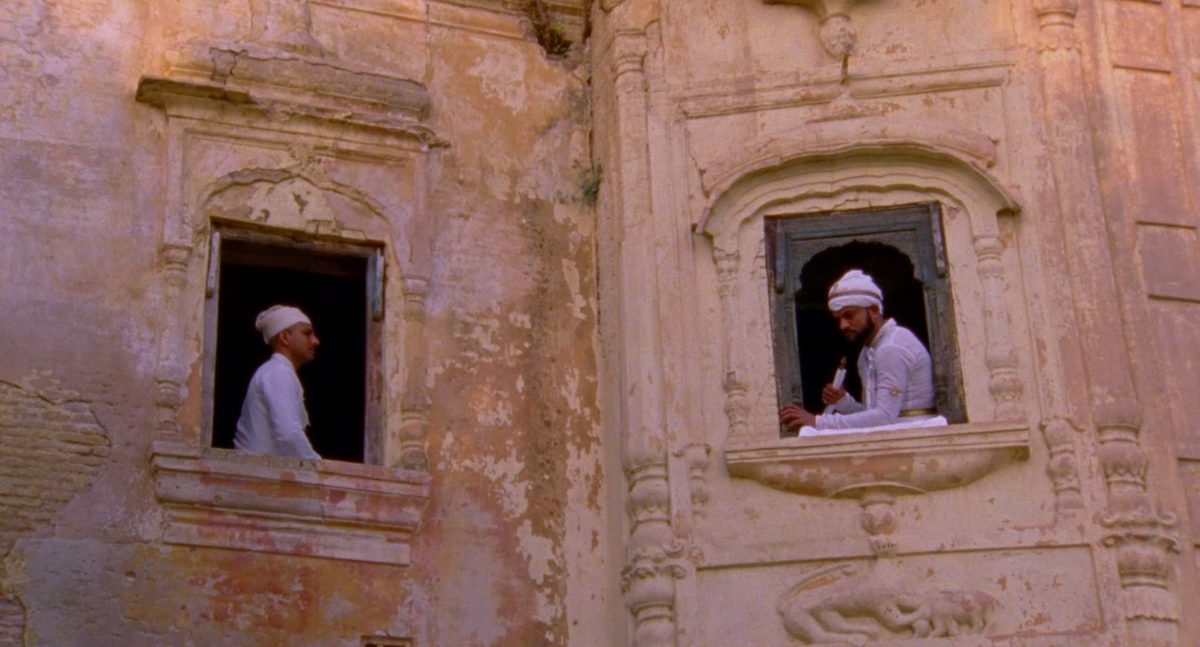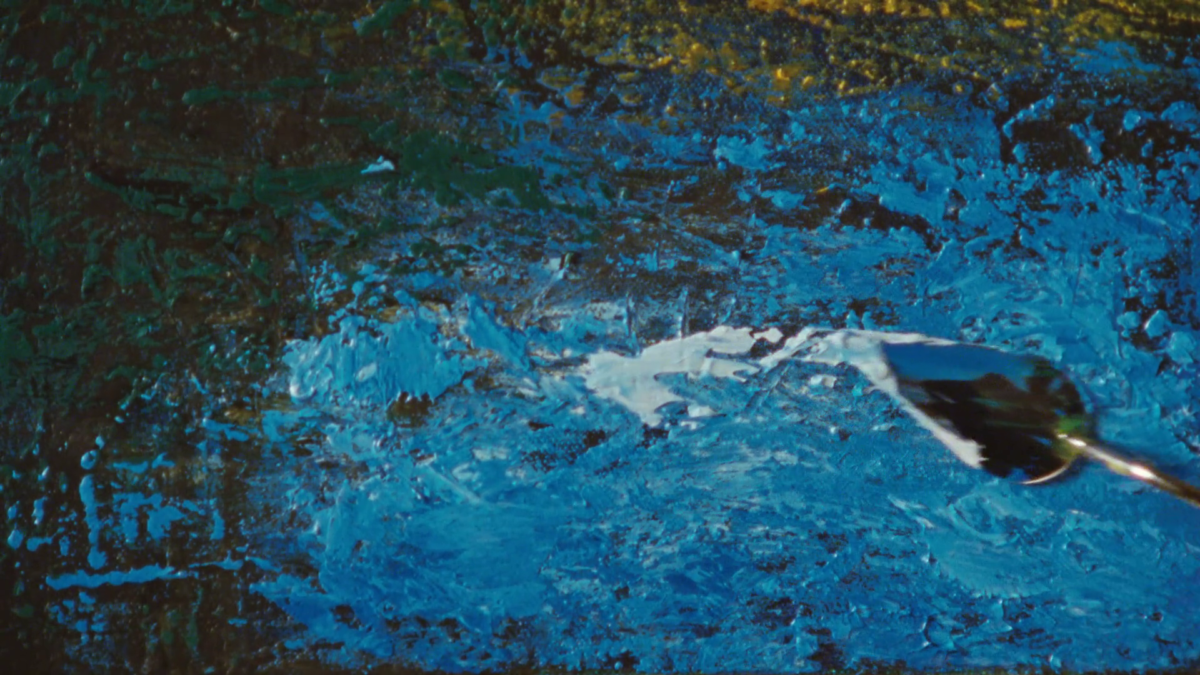Last year, Srikanth Srinivasan released the first book-length, career-spanning survey of the work of director Amit Dutta. It is titled Modernism by Other Means and was published in e-book form by LightcubeOrder the PDF of Modernism by Other Means (which will be available as a physical book in the immediate future) here: https://shop.lightcube.in/Modernism-By-Other-Means. They will soon be releasing the hardback physical edition. With rugged clarity and verve, Srinivasan walks us through an extensive portrait of an elastic artist.
In the interests of transparency, I should like to start by ‘admitting’ my connections to its makers. I have recently published an article by Srikanth Srinivasan on my own site, and I have recently screened a short film by Anuj Malhotra (who is very involved at Lightcube) via that same site.
In fact, one might say this entire project begins with Anuj, who appears in Dutta’s filmography aurally, as the narrator of Two Expeditions (2017). I met Anuj in 2015 through our mutual involvement in photogénie, and from the first time we spoke he has continued to bring into my consciousness a string of exciting filmmakers, critics and curators the world over. In 2017 he recommended Kramasha aka To Be Continued (2007), which I took in via a low-quality version available on YouTube. It was certainly impressive, yet I foolishly did not follow up, and it remained the only Dutta film I had seen prior to the release of Modernism by Other Means. Srinivasan’s condensation of Kramasha doubles as an excellent primer for the whole of Dutta’s filmography:
Time and space in Kramasha appear to be fluid and interchangeable. Present and past coexist as though they were contiguous spaces. With the logic of a dream, the camera’s oneiric geometric manoeuvres stitch different temporal realities into one seamless whole. The nomadic prophet weaves in and out of the stories being told. Narrative time is subject to contradictory forces of dilation and contraction. Episodes taking place over many years are wrapped up in a few seconds while prosaic actions, such as a hand reaching for a switch, are slowed down and filmed in their entirety.
This stitching of temporal realities weaves throughout Dutta’s work, and calls to mind a particularly startling moment in The Seventh Walk (2013), when we see painter Paramjit Singh seated next to a foregrounded blank canvas. We cut to a pedestal shot in the forest that surrounds his workspace, and 11 seconds later we cut back to the same shot, but this time the canvas is coated in radiant amber. 18 minutes later we return to the shot with the canvas once again blank.

A journey through Dutta’s filmography is also a journey through Indian art, often not only taking influence from but directly showing works, even reproducing pieces as tableaux vivants. Somewhere between artful biopic and Greenaway-esque tableaus rests Nainsukh (2010), which takes a different approach to painting than most Dutta shorts (of which there are many)—live-action remakes, covers and interpretations of works by the titular painter. Notably, we (or at least those of us unfamiliar with the originals) see the live-action renditions before seeing the originals. In an inversion which seems like a decision Dutta himself might be prone to make, the cover of Modernism by Other Means turns a shot from Nainsukh into a minimalist print, an extension of Dutta’s continuing efforts to render three-dimensional reality as a flat, two-dimensional canvas, recreating the Pahari paintings which inspired the film.
As someone who holds very little personal knowledge of ‘Indian culture’ (already a misnomer as India is so large as to contain a plethora of wildly differing cultures), Modernism by Other Means is nothing short of an essential aid not only in contextualizing Dutta’s films, but in some cases understanding the absolute basics of what each film communicates, the existing register it is working within or developing upon.
Before last year, Dutta’s body of workMany of Amit Dutta’s films can be rented on demand via the Matra Publications Vimeo page: https://vimeo.com/matrapublications (Thank you to Srikanth for pointing this out.) was largely unavailable to interested eyes, save for a few appearances on festival circuits, but apparently even those have lessened over time. That Dutta’s filmography was licensed for streaming rights by MUBI last year is an anomaly in in the world of virtual film screenings. In some regions (India), this has meant a slew of Dutta titles were instantaneously available. In others (Germany), it meant a trickle of piecemeal availability, a wait-too-long-and-you’ll-miss-it turnaround. Exactly one month before typing this sentence, I watched Nainsukh (2010) on the service. Now, without warning, it is no longer viewable.
To be perfectly honest, at first blush, Dutta’s films did not reach me on a personal level. Yet as I continued to dig, I learned that his work varies as much in style as it does in its interests. While he’s not strictly an ‘avant-gardist’ per se, the breadth of his style includes many a filmmaking mode hardly embraced outright by most arthouse-minded viewers. And despite our aesthetic differences in many cases, I admire him as an artist; uncompromising and constantly experimenting. Where many avant-gardists might settle into a single style and stick to it (this can reap visual and metaphysical rewards, no doubt!), Dutta often ventures far from the cradle of safety in every respect. He has worked with various stocks of celluloid, digital, mini-DV tapes and other formats. The works themselves range from the wordy to silent.
In Chitrashala aka House of Paintings (2015), Dutta begins by filming the interaction of framed paintings with their surroundings, using the reflections on glass to produce new works of art, until, halfway through, we enter the frame and the world of the paintings—figures are crudely animated in a Monty Python-adjacent mode, one which Dutta reprised last year for Wittgenstein Plays Chess with Marcel Duchamp, or How Not to Do Philosophy (2020). Dutta’s wife, Ayswarya Sankaranarayanan appears in the credits for both films; in the former as co-writer and in the animation department (as Ayswarya S. Dutta) in the latter. She also appears as second screenplay credit after Amit in The Seventh Walk. Note also that The Seventh Walk’s assistant director was none other than accomplished director Pushpendra Singh. Srinivasan on Chitrashala:
The museum, moreover, is almost devoid of human presence, giving an overarching feeling of a meticulous, Kubrick-like directorial control and formal severity at work. This steely muscularity of the first half is countered by the soft, sinuous style of the second. The ‘camera’ here is freer, traversing diagonals and craning over picture planes. The audio is peppered with sounds of women’s bangles and anklets, as it is with vibrant diegetic noise. The pace is more leisurely, with an average shot length of just over 6.4 seconds (88 shots spanning 565 seconds), compared to 4.9 seconds in the earlier segment (90 shots over 445 seconds).
It is this astute mathematical attention to detail alongside a metaphysical, poetic, and formal appreciation which makes the book a truly standout text.
Yet Dutta’s interests are hardly limited to painting nor visual art. With several published books to his name, Dutta takes delight too in the written word. In Blue Elephant (2016), he brings to life a scene from the poet and playwright Bhāsa, “dated between the 2nd century BCE and 2nd century CE,” as the opening title card informs us. Despite working so long ago, “His plays were discovered in 1909 A.D.” The twist? The work being read out loud is presented in total silence, accompanied by intertitles of brief excerpts, setting itself firmly in the tradition of silent cinema, the film’s sole actor miming exaggerated character studies. In the final three minutes of its mere 16Blue Elephant was originally presented with a runtime of 20-21 minutes, premiering at a 2017 retrospective in Bombay, curated by Srikanth Srinivasan. It seems that Dutta edited the film for its MUBI release, cutting a few minutes, adding in an animated elephant and slightly reworking the sound. (Again, thanks to Srikanth for this info.), a radical synth emerges on the soundtrack as the images shift from black and white to color.
Consistently well-researched, Srinivasan pulls quotes from Dutta interviews, and is able to draw parallels to other directors in style and project choices. With Blue Elephant he compares it to Paul Thomas Anderson’s Junun (2015). But most remarkably, he is able to write as much about Dutta’s short films as his features. Furthermore, in addition to providing context and drawing parallels to existing materials, there is no shortage of his highly personal and often mind-altering observations:
As always, what the filmmaker is interested in is the mechanics of artmaking and the material transformation a work of art undergoes as it travels from one medium to another. For Blue Elephant, the body of the actor, the book of Bhasa’s plays he reads and re-transcribes by hand, the house he performs in, and the camera that intermittently makes its presence felt—all serve as stations on the journey of an artwork. They are all physical signs—reincarnations, if you will—of the same creative impulse.
Even as one attempts to pin down Dutta’s work, he continues to produce it. I imagine this is not likely to be the final volume examining the artist to come into publication. Now only 43, he may very well just be getting started. Thus, this volume ends on a short coda titled ‘Recent Work (2019-2020)’, and Dutta has even released a new film since the book’s publication, The Game of Shifting MirrorsThe Game of Shifting Mirrors is free to stream in full: https://vimeo.com/465698776, which premiered last October at the Viennale.

On that note I should like to say a few words on a short film not covered in the book. Though it opens with a dedication to Jonas Mekas, the first third of the five-minute short The Day a Tree Fell (2019) feels deeply influenced by Rose Lowder, with its rapid (though not quite as rapid as Lowder’s usual single-frame approach) intercutting between two or more shots playing out simultaneously. The sequence reaches its apex of Lowder kinship when cutting between a close-up on a saturated red rose, and a wall of ivy, just before the entire rhythm breaks and gives way to a steady observation of a caterpillar, climbing a thread made invisible by shallow focus, so as to appear to simply float in the middle of a forest.
Like much of Dutta’s work, the short is shot on digital video, and given the constantly exposed visual limits of the material via compression of reality, one wonders if they are due to a budgetary constraint or a conscious attempt to play with such limitations. I’m inclined to believe it’s the latter, though it may just as well be an insistence upon continuing the work, regardless of constraints. Dutta’s modus operandi seemingly boils down to ‘try everything’, and the results are certainly fascinating. The Day a Tree Fell closes with a poem, a final ode to the Lithuanian poet-filmmaker.
I cannot hope in so few words to do justice to the oeuvre of Amit Dutta, nor to the in-depth study of his work contained within Srinivasan’s book. I can only say that for newcomers and veterans alike, whether you have seen twenty Dutta films or none, Modernism by Other Means is a vital guide writ by one master investigating another.
